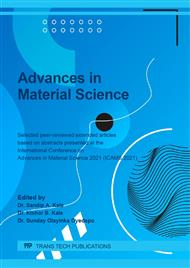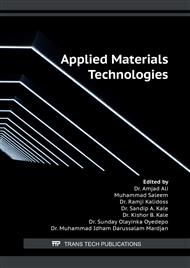p.139
p.145
p.153
p.163
p.177
p.183
p.191
p.199
p.207
Light Absorbance of Natural Dye Extracted from Local Plants for Dye-Sensitized Solar Cell
Abstract:
Dye-sensitizer is heart of dye-sensitized solar cell which is an electron donor when receiving irradiation on the surface. Dye can be classified as synthesized dye or natural dye. Natural dye can be obtained colourfully from various plants such as tomato, carrot, grapes, chili, and so on. In this work, three selected plants which are locally available were chosen for three different colours. Green colour was extracted from leaves of Tiliacora triandra (Ya-nang). Red colour was from flower of Hibiscus sabdariffa (Rosella), and purple colour was from fruits of Morus alba (Mulberry). They were dried and ground into powder and their colour was extracted using 95%-ethanol. The concentrations of solution were 5, 10, and 20 g of powder per 200 ml for solvent extraction of each colour. These three colours were tested for absorbance index indicating ability of light absorption. The absorbance index curves showed that Ya-nang in green colour gave the best absorbance index having several peaks at 458 and 675 nm wavelengths for the 20 g/200 ml solution. While Rosella in red colour showed the peak at 534 nm wavelength and Mulberry in purple colour gave peak at 666 nm wavelength. The characteristics from the absorbance index curves also revealed the type of colour pigment in the dye. It was found that Ya-nang in green dye, Rosella in red dye and Mulberry in purple dye contained “Chlorophyll”, “Anthocyanin” and “Betacyanin” pigments respectively. Moreover, the area under the curves obviously indicated that the area of the green colour from Ya-nang was higher than those of Rosella and Mulberry. This implied that Ya-nang had higher potential to be dye-sensitizer and would give better dye sensitized solar performance compared with Rosella and Mulberry.
Info:
Periodical:
Pages:
207-212
Citation:
Online since:
August 2022
Keywords:
Price:
Сopyright:
© 2022 Trans Tech Publications Ltd. All Rights Reserved
Share:
Citation:



